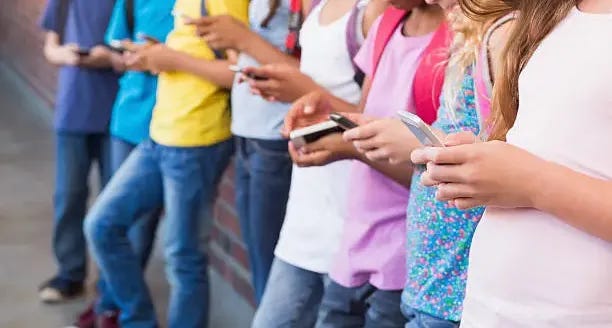Los Angeles Schools Ban Cell Phones: A Step Toward Focus and Learning
Addressing Distraction and Dopamine Overload
On February 18, 2025, students in the Los Angeles Unified School District (LAUSD) were officially banned from using cell phones on campus. The goal? To create a more focused and engaging learning environment by limiting distractions from social media and texting during school hours.
Why the Ban?
Research has long linked excessive cell phone use to anxiety, addiction, and attention issues among young people. "It is well known, based on medical research, that the levels of anxiety and young people’s addiction to cellular phones have increased," said LAUSD Superintendent Alberto Carvalho.
Before the ban, about half of LAUSD schools relied on an honor system—letting students keep their phones but trusting them to stay off them during class. Others had stricter rules. "Fifty percent of our schools obtained pouches that magnetically seal the phone during the day. The phone remains in the student’s possession but is secured inside a locked pouch," Carvalho explained.
The Science Behind the Ban: How Cell Phones Affect the Brain
Smartphones can be great tools when used wisely, but research shows that too much screen time can mess with key brain functions like attention, memory, and self-control. Wilmer, Sherman, and Chein reviewed studies on smartphone habits and found that while research is still evolving, excessive phone use is linked to shorter attention spans, weaker memory, and trouble delaying gratification (Wilmer et al.). They also noted that more studies are needed to fully understand how long-term phone use affects cognitive function (Wilmer et al.).
So why are students so glued to their phones? It all comes down to dopamine—the brain chemical that makes things feel rewarding. Social media apps, notifications, and texts create a cycle of dopamine surges that make it harder to put the phone down. Here’s why:
Unpredictable Rewards – Notifications, likes, and messages hit at random, making phone use addictive—kind of like a slot machine.
Instant Gratification – Quick bursts of entertainment from TikTok or Instagram train the brain to crave constant stimulation.
Social Validation – Likes, comments, and reactions trigger dopamine, reinforcing the urge to check your phone over and over again.
The Problem: Dopamine Overload
Too much phone time overloads the brain’s reward system, making it harder to focus. Social media and texting move fast, so traditional learning—reading, writing, deep discussions—feels slow in comparison. Teachers are noticing that it’s harder to keep students engaged in anything that requires patience or deep thinking.
A Solution: Trying a Dopamine Detox in Schools
For schools that aren’t enforcing a full phone ban, a dopamine detox can be a game-changer. It helps students reset their attention spans and get used to focusing without constant phone interruptions.
How to Try a Dopamine Detox in the Classroom
Step 1: Set the Expectation
Let students know what’s happening:
"Today, we’re doing a dopamine detox. That means cutting distractions and focusing on deep learning. It might feel weird at first, but stick with it—you’ll notice a difference in how you think and focus."
Start with just one class period or an hour, then build up from there.
Step 2: Remove High-Dopamine Distractions
Phones go away—out of sight, out of mind.
Background noise is kept to a minimum.
Students focus on one task at a time.
If screens are needed, switch them to grayscale to make them less visually stimulating.
Step 3: Replace Distractions with Deep Engagement
Instead of jumping from one thing to another, encourage activities that require sustained focus:
Silent or deep reading
Group discussions that make students think
Hands-on projects (science experiments, creative writing, problem-solving)
Mindfulness exercises (deep breathing, quiet reflection)
Step 4: Try the Silent Focus Challenge
Set a timer for ten minutes and have students work in complete silence. At the end, ask them:
"What did you notice about your focus?"
Some might feel restless at first, but many will realize that they’re actually more focused once they get past the initial discomfort.
Step 5: Reflect and Reintroduce Tech with Balance
After the detox, have students reflect on their experience:
What felt different?
What was easier or harder than expected?
How can this help when studying or doing homework?
Instead of banning technology completely, help students build better habits—like setting app limits or using study techniques like the Pomodoro Method (25 minutes of focus, 5-minute breaks).
Why This Works
A dopamine detox won’t magically fix attention issues overnight, but over time, it helps students reset their focus. It leads to:
Stronger attention spans
Less restlessness
More meaningful class discussions
Better self-control with technology
Most importantly, it teaches students how to manage their own focus, instead of just taking their phones away and hoping for the best.
Final Thought:
We blame kids for being distracted, but the truth is—we’ve built a world designed to keep them that way. Instead of just banning phones and expecting attention spans to improve, we should teach students how to rebuild their focus and show them why it matters.
A dopamine detox is one small step in the right direction.
Would you try this in your classroom? Have you already? Share what’s worked for you!
Works Cited
Wilmer, Henry H., Lauren E. Sherman, and Jason M. Chein. “Smartphones and Cognition: A Review of Research Exploring the Links between Mobile Technology Habits and Cognitive Functioning.” Frontiers in Psychology, 2017, PMCID: PMC5403814, PMID: 28487665, https://pmc.ncbi.nlm.nih.gov/articles/PMC5403814/.


